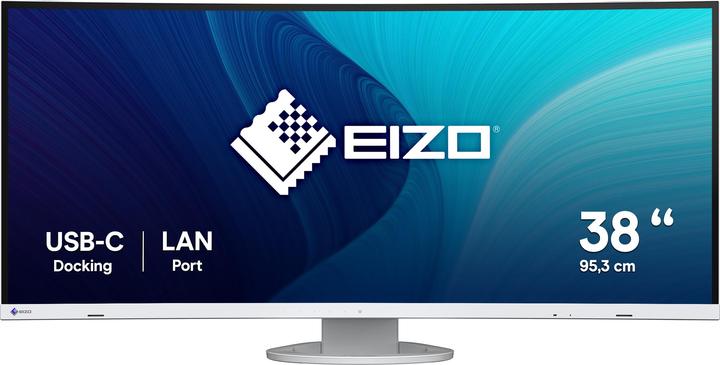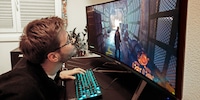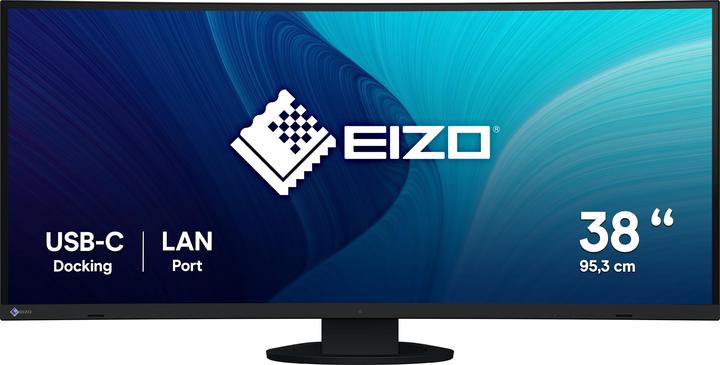

Testing a gigantic curved monitor: the 37.5-inch Eizo FlexScan EV3895
Eizo's first curved monitor is absolutely huge: 37.5 inches diagonally at 3840 × 1600 pixels. Primarily intended for office work, it offers a nearly accurate representation of the sRGB and DCI-P3 colour spaces. Sounds good, but I do have reservations about the rather lacklustre 60 hertz image composition.
Eizo's first curved monitor, the FlexScan EV3895, is an impressive 37.5 inches across – a gentle giant, as its curvature is only 2300R. If you were to surround yourself with 2300R curvature displays, you'd be exactly in the centre of a circle with a 2.3-metre radius. Whether the curvature is purely aesthetic or actually adds something is up to you to decide. According to some studies, our eyes tire up to 60 per cent slower with these wonky monitors.
Personally, I like curved monitors. I feel closer to the action. This could be because our eye's field of view is also curved. Our curvature lies somewhere around 1000R. However, I don't think curved display surfaces are less tiring for our eyes. Especially not with the present model, since only 60 hertz are possible with the Eizo panel.

The monitor is available in black or white.
Technical data according to the manufacturer:
- 37.5-inch UW-QHD+ IPS panel with flicker-free LED technology, 3840 × 1600 pixels, 24:10 format, curved, anti-glare.
- Frequency: 60 Hz.
- Response time (grey to grey): 5 ms (with activated overdrive function).
- Maximum brightness: 300 cd/m².
- Contrast ratio: 1000:1.
- Colour depth: 8-bit.
- Colour space coverage: 100% sRGB, 94% DCI-P3.
- Stability of the viewing angle: 178 ˚.
- Screen curvature: 2300R.
- Connections: 1 x USB Type-C (DisplayPort HDCP 1.3, Power Delivery up to 85 W), 1 x DisplayPort (HDCP 1.3), 2 x HDMI (HDCP 2.2/1.4), 2 x USB 3.1 Gen 1 Type-B (upstream), 4 x USB 3.1 Gen 1 Type-A (downstream), Ethernet Port.
- Speakers: 2 × 1 watts.
- Additional features: height adjustable by 192.7 mm, tilts 35° back and 5° forward, swivels 70°.
- Dimensions w/stand: 893.9 x 411-603.7 × 240 mm, 13.2 kg.
Design and ports
Eizo's bendy boy is a true monster that doesn't take up considerably more space than a flat model thanks to a weak curvature and small stand. Looking at the plain, black monitor when it's off, I notice that the edge is only one and a half millimetres thick. However, Eizo, like many other display and TV manufacturers, is faking something. When I turn it on, the margin on the sides and above the image expands by eight millimetres.
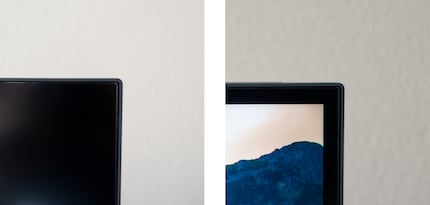
A detail that doesn't really bother me when working. Nevertheless, you've got an immense 95.3 centimetres across, which means the visible image size is 879.7 × 366.5 millimetres.
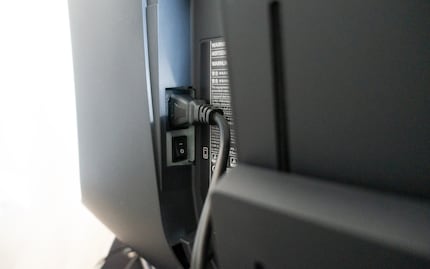
The power supply is built directly into the device. Another plus, this way only a common C13 power cable has to be connected. In general, I've got no complaints in terms of connections: two HDMI inputs, one DisplayPort and one USB Type-C. The latter can also be used for charging external devices and offers up to 85 watts. Furthermore, two 3.1 Gen 1 Type-B USB upstream ports and four USB 3.1 Gen 1 Type-A downstream ports are available.
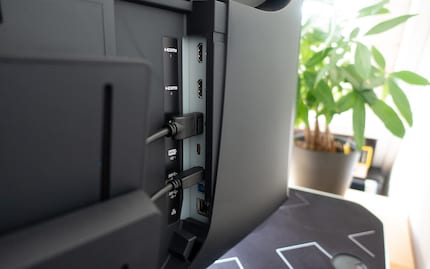
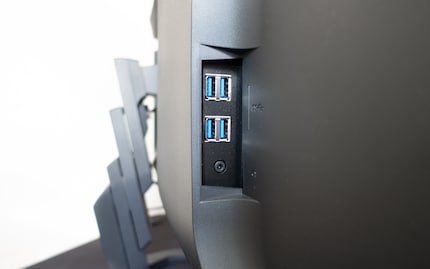
Eizo isn't stingy, including a cable for each signal input and upstream port. There's also a cover behind which the ports can be hidden if necessary.
Operation and OSD
In contrast to other manufacturers who like to hide the OSD controls on the right behind the display, Eizo places all controls in the centre below the screen. There's a power button and six knobs next to it.
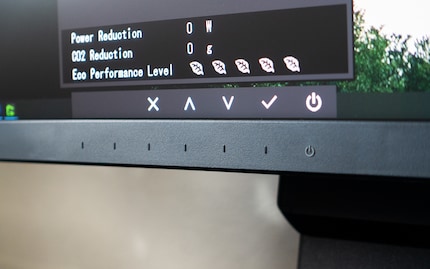
The OSD is called up by touching whichever knob. The use is self-explanatory, as corresponding elements are always located above one of the knobs. On the far left of the basic menu, the signal source can be selected. If I touch the second selector, a submenu with predefined image settings appears: two user-defined modes, sRGB, Paper, Movie and DICOM for displaying medical content.
A third item on the top level of the menu is for quick adjustment of brightness and volume, and a fourth for all settings. If you want, you can set the two user modes in detail: in addition to brightness, you can also select contrast, colour temperature, gamma, and overdrive, hue, saturation, and gain settings for red, green, and blue in a nested submenu. In addition, a two-stage super resolution function can be activated – this sharpens lower quality content by highlighting object edges. However, the function degrades the image and especially the font at high resolutions. Furthermore, power saver settings as well as options for Eco mode, automatic brightness and for the power LED can be selected in the menus.
If that still isn't enough, the Eizo software «Screen InStyle» can offer even more settings. For example, automatically assigned colour modes when starting a program. Or the synchronisation of settings when using multiple monitors.
Brightness, uniformity and colour space coverage
According to the spec sheet, the monitor offers a maximum brightness of 300 cd/m². I measured the accuracy of that data and how homogeneous the illumination is using the x-rite i1Display Pro.
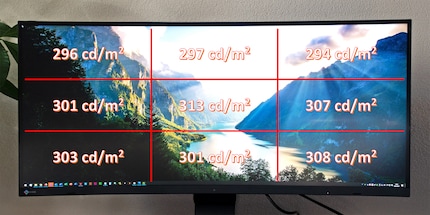
The brightness of the present panel is 302 cd/m² on average. This makes working during the day without direct lighting incredibly easy. I'm astonished by the uniformity, practically unheard of on a large monitor. The biggest difference is comparatively small, located between the centre and the upper right edge. It's only 19 cd/m².
What amazes me even more when measuring the colour space coverage: the sRGB and Movie modes should reproduce the sRGB and DCI-P3 colour spaces better than the basic settings. But they don't. When I measure the display using default user profile settings and deactivated Eco mode, I get a colour space coverage of 99.7 per cent for sRGB, 83.2 per cent for Adobe RGB and 93.3 per cent for DCI-P3. In sRGB mode, on the other hand, the sRGB colour space is only covered by 98.6% and the important DCI-P3 colour space is only covered by 93.2% under Movie. Thus these additional modes are more window dressing than really useful. Furthermore, the default settings don't reach the 100 per cent sRGB and 94 per cent DCI-P3 targets. In return, the relatively solid representation of Adobe RGB at 83.2 per cent is surprising.
I calculated a static black and white contrast of 940:1. According to Eizo, it should be 1000:1, but even with a bit less, the image appears extremely crisp.
Working, watching movies… and gaming too?
The device is well suited to work: the huge, wide screen at a high resolution offers immense space and a good viewing angle stability of 178 degrees. I can use it to keep an eye on various windows, thus gaining time and not losing track of things. I can easily write this article on the left half of the screen, or even just a third of the screen, and keep both my mail and an additional window open for research next to it. This is how it should be. However, a mediocre frame rate unfortunately keeps it from achieving perfection. The fact that the monitor only achieves 60 hertz is striking, since I'm currently testing a notebook display with 300 hertz. When I sit back down at Eizo's monitor, I have to get used to it for a few minutes. I feel slight pressure on my eyes each time, which disappears after a few minutes.
When watching a movie on this monitor, I'm initially thrilled despite the missing HDR function. The big picture is pleasing, but I notice that choppy picture elements creep in when the camera pans sideways. Therefore, I call up a test video on YouTube, which confirms my suspicion: the monitor has a screen tearing problem, which isn't unusual for panels with missing adaptive synchronisation. But it's annoying, especially when gaming. Even the overdrive function, which is supposed to enable a grey-to-grey response time of 5 milliseconds, cannot comfort me. Furthermore, this disqualifies the panel from video editing work.
At least I didn't notice any ghosting or backlight bleeding on this display. In addition to screen tearing, it also has problems with motion blur, which doesn't disappear even with activated overdrive. A motion blur reduction function is regrettably missing.
The stereo speaker from hell
Never in my life – and I'm not exaggerating – have I experienced such horrendous speakers. They sound like someone next to you on the train listening to music too loudly with cheap headphones. Neither the mids nor the basses are really discernible. Only the highs come out halfway clean. In addition, the speakers are much too quiet and hiss a bit when they're turned on full blast and no sound is playing. Even Fisher Price radios from the ’80s sound better.
My tip to Eizo: just leave it be and don't install these insipid speakers.
Conclusion: for the office, yes, for other things, no
Eizo's curved 37.5-inch giant in a 24:10 format does well during simple tasks. Its large picture has excellent, homogeneous illumination and near exact colour reproduction. It offers plenty of connectivity options and further convinces with its design and great viewing angle stability. It can also be ergonomically adjusted to perfectly fit the user in front of the screen in terms of height and inclination.
However, it's let down by the lacking 60 hertz refresh rate. A killer argument against using the monitor outside of office work can be the lack of adaptive synchronisation – or screen tearing as well as motion blur when watching movies and playing games. The stereo speakers are completely useless.
Why does the monitor even cost so much?
I find my muse in everything. When I don’t, I draw inspiration from daydreaming. After all, if you dream, you don’t sleep through life.

